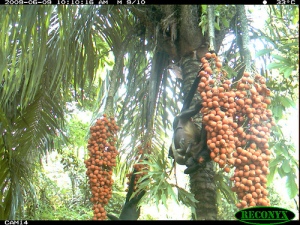Every friday, along with the usual tracking equipments and seed preparation kit (every agouti team member has his/her own personalized one), I add in my binoculars and census data sheet. I head out earlier than usual in order to finish the census before the pendulous infructescences shine under the bright sunlight like wet seals under the sun and make it hard to count the fruits that are hanging onto them. I walk on the trails that wind through the 25 ha grid and look for black palm trees that are participating in the census. One will not miss the palm with its needle-like spines covering its entire trunk. I then view through my binoculars and count the infructescences with fruits and the number of fruits in each infructescence.
The census started during the first week of April when the entire island bid farewell to the dry season and welcomed the wet season. 57 black palm trees participated in this census, some with all of their infructescence full of fruits, some with few empty infructescence, some with ripe fruits (the fruits are super orange when ripe) and some with a mixture of ripe and unripe fruits. They contributed to a total of 16993 fruits. Now after 8 weeks of weekly census, only 27 trees remain with about 3539 fruits.
When it is very windy, the pendulous infructescences swing with the wind and release some fruits on the forest floor for common agoutis and spiny rats. Arboreal mammals like the howler monkeys jump onto the palm trees from the neighboring trees and hang onto the infructescence with the aid of their prehensile tails and grab onto the fruits and munch on their juicy flesh. They then throw the seeds covered in some flesh that sometimes land on the heads or footsteps of curious human beings and are then carried by agoutis and turned into invaluable caches!
Karin Steijven took this video of howler monkeys feasting on Astrocaryum fruits while she was collecting Astrocaryum seeds for her master’s project.











